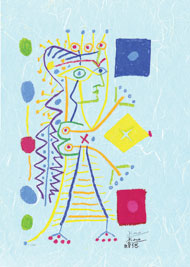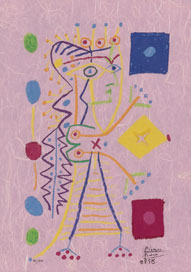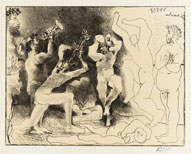

|
|
Pablo Picasso 1881-1973. The greatest painter and most innovative sculptor of the twentieth century, Pablo Picasso was also its foremost printer. His graphic oeuvre spans more than seven decades, from 1899 to 1972. His published prints total approximately 2000 different images pulled from metal, stone, wood, linoleum and celluloid. His unpublished prints, perhaps 200 more, have yet to be exactly counted. Picasso’s prints demonstrate his intuitive and characteristic ability to recognize and exploit the possibilities inherent in any medium in which he chose to work. Once he had mastered the traditional methods of a print medium, like etching on metal, Picasso usually experimented further, pursuing, for example, scarcely known intaglio techniques such as sugar-lift aquatint. The printed graphic work of Picasso shows a clearly defined succession of periods in which certain techniques predominated. Early on, the copperplate, with its variants of the etching and dry point, fascinated the young artist. In the Parisian ateliers of the masters of this craft, Eugene Delatre, Louis Fort and above all, Roger Lacouriere, he was introduced to many new techniques. Later, Picasso acquired his own press on which he made many trial proofs and further explored the secrets of printmaking. Between 1919 and 1930 he occasionally turned his hand to lithography. Then, in the etchings of the Vollard series, his creative powers reached a first culminating point. Most of the compositions that followed during the war years were intended for book illustrations. The year 1945 marks the inception of his great lithographic work in the atelier of Fernand Mourlot. It seems almost as though he was now eager to make up for lost time. His growing mastery of the medium and his inventive genius soon enabled him to venture into domains new to lithography and to achieve bold and striking effects. After World War II, Picasso’s production as a printmaker substantially increased and etching and engraving continued to be his favorite medium for graphic expression. During several concentrated spans of time, however, he was profoundly involved with two other techniques: first lithography on stone, (and its surrogate, zinc) and subsequently, linocut, a relief method of carving and printing similar to woodcut but utilizing a linoleum instead of a wood surface. Picasso adapted the processes of both lithography and linocut to his own language and to his individual methods as a peintre-graveur. His continual inventiveness sometimes challenged his collaborators, the printers, to the limits of their own skills as craftsmen. In 1963 Piero and Aldo Crommelynck brought a hand press from Paris to Mougins, where the artist had settled permanently. From then on, his etching, dry point and aquatint would translate into black and white on colour compositions of unfailing inspiration.
|
![]()

Blue Jacqueline
Colour lithograph
53 x 38 cm

Pink Jacqueline
Colour lithograph
53 x 38 cm

La Danse